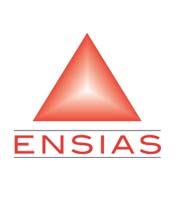- Accueil
-
L'Ecole
-
FORMATIONS
-
FORMATION INGENIEUR
-
Nouvelles filières offertes
- Ingénierie Intelligence Artificielle (2IA)
- Smart Supply Chain & Logistics (2SCL)
- Business Intelligence & Analytics (BI&A)
- Cybersécurité, Cloud et Informatique Mobile (CSCC)
- Data and Software Sciences (D2S)
- Génie de la Data (GD)
- Génie Logiciel (GL)
- Ingénierie Digitale pour la Finance (IDF)
- Smart System Engineering (SSE)
- REGLEMENT DES ETUDES DE L’ENSIAS CYCLE INGENIEUR
-
Nouvelles filières offertes
-
FORMATION INGENIEUR
- FORMATION CONTINUE
-
Recherche
- INTERNATIONAL
- ENTREPRISES
- VIE ESTUDIANTINE
- BIBLIOTHEQUE
LES DERNIÈRES INFORMATIONS
New approaches for solving the container stacking problem
| Titre | New approaches for solving the container stacking problem |
| Publication Type | Conference Paper |
| Year of Publication | 2016 |
| Authors | Razouk, C, Benadada, Y, Boukachour, J |
| Editor | Alaoui, AE, Benadada, Y, Boukachour, J |
| Conference Name | PROCEEDINGS OF THE 3RD IEEE INTERNATIONAL CONFERENCE ON LOGISTICS OPERATIONS MANAGEMENT (GOL'16) |
| Publisher | Sidi Mohammed Ben Abdellah Univ Fes, Fac Sci & Technol; Mohammed V Univ Rabat, ENSIAS Sch; Univ Havre; IEEE |
| ISBN Number | 978-1-4673-8571-8 |
| Abstract | Containers shipment has grown very fast during the last ten years, in Tanger Med port for example, 3Millions containers (80% in transshipment) TEUs (Twenty feet equivalent unit) has been changed during 2015 (Tanger Med Port authority ``TMPA{''} study March' 2016 {[} 1]), which correspond to an increase of 40% comparing with the last study made in 2012. Thus, our study will deal with the port management and the improvement of the operations processes. The aim of this paper is to define a new strategies to solve the container stacking problem (CSP) using an approach of optimization. Thus we define a new MIP (Mathematical Integer Program) to deal with the operational tasks in a containers terminal. In which we optimize the number of the stacks used to store a given number of inbound containers and also we minimize the related cost of the traveling distance for inbound containers between the sea side and the yard side. This paper is organized as follow: we introduce and locate first our problem, then we present the literature review of the CSP. The problem definition and the MIP introduction will be the subject of the next section, and we finish by presenting the findings and the future perspectives. As a proposed resolution approach for our MIP, we propose a developed genetic algorithm strategy (DGAS) as a metaheuristic and the Branch & Cut (B&C) as an exact method. Our main objective is to avoid reshuffles and to find out the best yard configuration to store inbound containers. The DGAS will be applied to an existing instances in the literature, and the obtained numerical results is compared with the Cplex results (B&C). The main inputs for our proposed framework are the height, weight, destination, type containers & yard bays, and the expected departure time (EDT). Our objective at the end is to have an optimized guide to the planners to easily define the unloading plan and the storage position for each container, giving an initial stacking state and a container demand. |
Revues:
LIENS UTILES
Localisation
Contactez-nous
ENSIAS
 Avenue Mohammed Ben Abdallah Regragui, Madinat Al Irfane, BP 713, Agdal Rabat, Maroc
Avenue Mohammed Ben Abdallah Regragui, Madinat Al Irfane, BP 713, Agdal Rabat, Maroc
![]() Télécopie : (+212) 5 37 68 60 78
Télécopie : (+212) 5 37 68 60 78
![]() Secrétariat de direction : 06 61 48 10 97
Secrétariat de direction : 06 61 48 10 97
Secrétariat général : 06 61 34 09 27
Service des affaires financières : 06 61 44 76 79
Service des affaires estudiantines : 06 62 77 10 17 / n.mhirich@um5s.net.ma
CEDOC ST2I : 06 66 39 75 16
Résidences : 06 61 82 89 77
Education - This is a contributing Drupal Theme
Design by WeebPal.
Design by WeebPal.



































